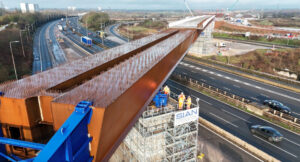Highways England has confirmed a number of proposals as part of its commitment to improve smart motorways.
The plans come as part of the organisation’s annual report which suggests 18 changes.
In October 2019, the Secretary of State for Transport asked the Department for Transport (DfT) to carry out a stocktake of the safety of smart motorways.
Published in March 2020, the Smart motorway safety evidence stocktake and action plan established that, in ‘most ways’, smart motorways are at least as safe as, or safer than, the conventional motorways they replaced. “However, there are individual risks within their operation that could be further reduced to improve safety and public confidence. We are determined to do all we can to make our roads as safe as possible, and we will take forward the measures set out by DfT,” said the annual report.
“We have agreed with government an 18-point action plan to make smart motorways safer and increase customer confidence in using them. Recognising concerns, we will strengthen our existing communications and public awareness messages, aimed at improving our customers’ understanding about how to use smart motorways and what to do in an emergency,” it added.
The changes include the investment of £5 million extra to further increase public awareness and understanding of smart motorways and how to use them confidently. “We will ensure drivers receive advice to help them keep safe on smart motorways, including advice on what to do in a breakdown,” said the report. There will be an end to the use of dynamic hard shoulders by converting dynamic hard shoulder sections to all-lane running to end driver confusion over different types of smart motorway. Also included is faster roll-out of stopped vehicle detection to all sections of smart motorway currently without it so stopped vehicles are, in most cases, detected in 20 seconds. Future designed schemes will have this technology as standard, said Highways England.
The organisation is also committing to a new standard for spacing of places to stop in an emergency, with a maximum of one mile apart. We will look to, where feasible, provide them every 0.75 miles apart so that, on future schemes, motorists should typically reach one every 45 seconds at 60mph.
The changes in full:
1. Ending the use of dynamic hard shoulders by converting dynamic hard
shoulder sections to all-lane running to end driver confusion over different types of smart motorway.
2. Faster roll-out of stopped vehicle detection to all sections of smart motorway currently without it so stopped vehicles are, in most cases, detected in 20 seconds. Future designed schemes will have this technology as standard.
3. Faster attendance by more Highways England traffic officer patrols on
smart motorways where the existing spacing between places to stop in an
emergency, such as motorway services and emergency areas, is more than one mile, reducing the attendance time from an average of 17 minutes to 10 minutes.
4. Committing to a new standard for spacing of places to stop in an
emergency, with a maximum of one mile apart. We will look to, where feasible, provide them every 0.75 miles apart so that, on future schemes, motorists should typically reach one every 45 seconds at 60mph.
5. Delivering ten additional emergency areas on the M25 on the sections of
smart motorway with a higher rate of live lane stops, and where places to stop in an emergency are furthest apart.
6. Considering a national programme to install more emergency areas on
existing smart motorways, where places to stop in an emergency are more
than one mile apart.
7. Investigating M6 Bromford viaduct and sections of the M1 to understand
what more could be done on these sections where multiple collisions
have occurred.
8 Making emergency areas more visible – all emergency areas will have a bright orange road surface, better signs on approach showing where they are, and signs within them giving information on what to do. These will be installed by the end of spring 2020.
9. Installing more traffic signs giving the distance to the next place to stop
in an emergency so you should almost always be able to see a sign (typically
these will be between 300 and 400 metres apart), helping drivers reach a safer place to stop.
10. More communication with drivers by improving public information, spending £5 million extra to further increase public awareness and understanding of smart motorways and how to use them confidently. We will ensure drivers receive advice to help them keep safe on smart motorways, including advice on what to do in a breakdown.
1.1 Displaying ‘report of obstruction’ messages automatically on electronic signs to warn oncoming drivers of a stopped vehicle ahead.
12. Displaying places to stop in an emergency on your satnav by working with satnav providers to ensure that places to stop in an emergency, such as
emergency areas, are shown on the screen of the device when needed.
13. Making it easier to call for help if broken down by working with car
manufacturers to build greater awareness and understanding of ‘eCall’
functionality, which is standard in all new cars from April 2018.
14. Completing the upgrade of digital enforcement cameras across the smart motorway network, enabling Red X signs to be enforced.
15. Updating the Highway Code to provide more guidance for motorists on smart motorway driving.
16 Closer working with the recovery industry, improving collaboration, training and procedures.
17 Reviewing existing emergency areas where the width is less than the current standard; and if feasible and appropriate we will widen to the current standard.
18. Supporting the DfT in their immediate review of the use of red flashing lights for recovery vehicles.






















